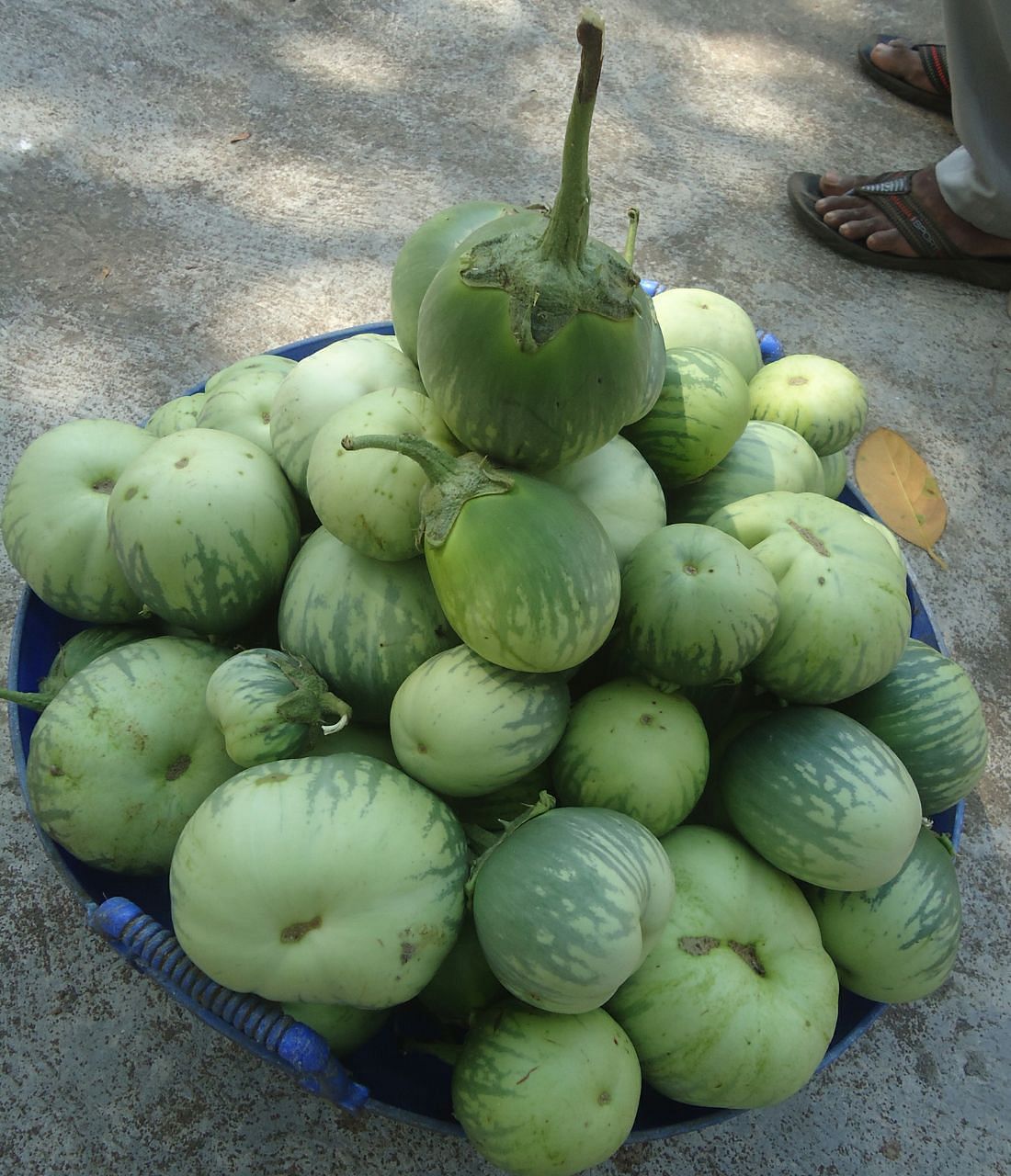
The sacredness and savouriness of Mattu Gulla have made it one of the favourite vegetables of Udupi cuisine. It’s size, shape, taste and flavour add to the fame of this special variety of brinjal, grown in the hamlet of Mattu near Katpady in Udupi district. This vegetable draws its name from the place where it is grown exclusively.
Legend has it that Saint Vadiraja of Sode Math in Udupi gave the seeds of this brinjal variety to the people of Mattu five centuries ago and asked them to grow it. This is a rare example of a vegetable acquiring fame with religious patronage. In fact, sambar prepared using Mattu Gulla is considered as a very special offering at the Math.
Though it has the shape of the purple brinjal, Mattu Gulla is green in colour with light green stripes. It has thin skin, thick pulp and fewer seeds. Known for its unique taste and flavour, Mattu Gulla is also rich in iron. Over 200 farmers grow Mattu Gulla in about 200 acres in Mattu and surrounding hamlets such as Pangala, Kopla and Kaipunjal. The uniqueness of this vegetable doesn’t just lie in its size, taste and flavour but also in the fact that all these qualities change the very moment it is grown in other areas, even in the neighbouring villages like Kaup. The reason why this variety of brinjal grows very well in Mattu is perhaps due to its proximity to the seashore. Mattu Gulla is grown on sandy soil that is rich in fish meal manure.
“It is a seasonal vegetable and its seeds are sown in the month of September. The demand soars as soon as it enters the market in January. The season ends in May. This vegetable has brought fame to the village,” says Sadashiva, a farmer in Mattu. While it is mainly consumed in the districts of Udupi and Dakshina Kannada, it is also preferred in other places like Bengaluru. In spite of all these advantages, the growers never used to get a good price, mainly due to the interference of middlemen.
Growers’ Association
To address this issue, as many as 162 growers came together and formed a group called Mattu Gulla Growers’ Association in 2010. Apart from getting a better price for the vegetable, the association also supported farmers by giving necessary inputs. The fact that the vegetable enjoys Geographical Indication (GI) tag made it popular in other regions and boosted its sale. About a year ago, they went a step ahead and created stickers to paste on the vegetable as a stamp of authenticity. With this, the marketing efforts got a boost and now, all the members market their produce through the association. The rates are fixed in the weekly meetings based on the production cost and the demand in the market. Last year, over 23,000 tonnes of brinjal was sold through the association.
There are three categories of Mattu Gulla available in the market. The first category ones are big in size and best in quality, the second category has those that are small in size but good in quality and damaged brinjals are categorised into the third. The Mattu Gullas in the third category are not considered for sale. The wholesale price of Grade 1 Mattu Gulla is Rs 75 per kg while its retail price is Rs 120-150 per kg. For Grade 2 Mattu Gulla, the wholesale price is Rs 40 per kg, while its retail price is Rs 70-75 per kg. Right now, the first category Mattu Gullas are given stickers and sent to markets in Bengaluru and Delhi. The vegetable is even exported. “The second category vegetables will also be given stickers shortly,” says Lakshman Mattu, the chief executive officer of the association.
The trademark sticker, said to be the first such attempt in the State, carries the picture of Saint Vadiraja and the name of the association. The growers get this sticker on their crop after careful examination by a committee. The entire process is monitored regularly to prevent misuse. They get a yield of 10 to 12 tonnes per acre.
Farmers say that the soil fertility has reduced over the years due to many reasons. This made them use chemical fertilisers for a couple of decades but now with the growing awareness about eco-friendly practices, the use of chemical inputs has reduced considerably. Today, new techniques are used to grow vegetables and Mattu Gulla is not far behind. Traditionally, Mattu Gullaseeds were sown directly in the soil and conventional methods of cultivation were followed. The new method of cultivation involves growing the saplings in pro-tray and then planting them in soil covered with a plastic mulch sheet and watering them through drip irrigation. This method protects the plant from insects and diseases. Though there is not much difference in the yield, the modern technique of cultivation has reduced the cost of cultivation to a great extent.
The success story of Mattu Gulla might trigger such efforts in other places that are identified with unique vegetables and fruits.